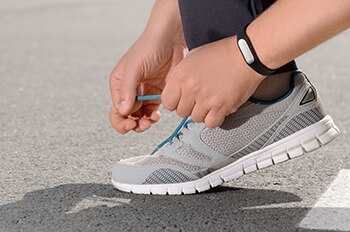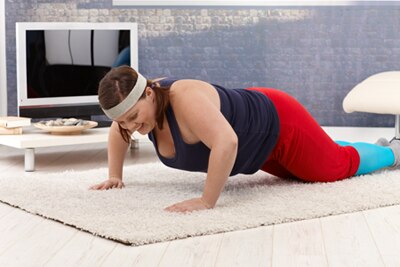Tips to Keep Moving
If you have made an effort to fit more physical activity into your day, that is great! If you need motivation to keep it going, it may help to—
Track your progress.
Seeing your progress over time may help you keep at it. You can track your progress on paper, online, or with an app for your phone or computer. Monitor the type of activity you did, how long you did it, and how you felt. Use this information to chart your progress, overcome setbacks, stay motivated, and set new goals.
If you're looking for an online tool, the NIH Body Weight Planner lets you tailor your calorie and physical activity plans to reach your personal goals within a specific time period.
Another way to see your progress is on a smartphone, mobile device, or computer. You can download a fitness app that allows you to enter information and gauge your effort.
Devices such as pedometers and fitness trackers can help you count steps, calories, active minutes, hours of sleep, and more. You wear most of these devices on your wrist like a watch or clipped to your clothing. Some of the devices can also track your heart rate and how far you walk or run during a certain period of time.

Be safe.
Be sure to play it safe, regardless of which activities you choose. An injury could cause a setback, keep you from meeting your physical activity goals, and affect how active you are in the future.
- Start slowly. If you are starting a new physical activity program, go slowly at first. Even if you are doing an activity that you once did well, begin little by little to lower your chance of injury or burnout.
- Stay hydrated. Remember to drink liquids. Water is an option. Sports beverages have a lot of sugar, will add extra calories, and aren’t necessary for most moderate activity.
- Listen to your body. Take it easy at first and see how you feel before trying more challenging workouts. Stop if you feel out of breath, dizzy, faint, or nauseated, or if you have chest pain or any other type of pain.
- Address existing health issues. If you have an injury or health problem such as diabetes or heart disease, talk with your health care professional about how to add physical activity to your life safely.
- Think ahead and plan for setbacks. Have options ready in advance in case of bad weather, injury, or other unusual events. If you do get off track, don’t give up. Regroup and focus on meeting your goal again as soon as you can.
Keep it going and build on your progress.
Choosing physical activities you enjoy and that match your interests and abilities may help you stick with them for the long run. You can try new activities, too. To add variety
- do low-impact aerobics or water aerobics
- walk on a treadmill or outdoors
- try seated aerobics or wheelchair basketball
- go on a bike ride (Don’t forget the helmet.)
Increase physical activity slowly over time.
As you reach your goals, think about how you can up the intensity or time spent being active. To reduce injury risk, increase physical activity gradually. First, increase the number of minutes you engage in an activity per session or the number of times that you do an activity each day or each week. For example, if you are walking 3 days a week, add another day. Later, up the intensity by walking faster or jogging.
Little by little, raise the number of times you do each strength-training activity. For instance, first work up to 2 sets of 10 to 15 repetitions with a 1-pound weight. When that is easy for you, consider trying the activity with a 2-pound weight. Make changes slowly. If you add weight, do fewer repetitions until you get used to the greater intensity.
As you build stronger muscles, consider new strengthening activities, too. Do moves that use your body weight and test your upper body strength, such as push-ups. Start with bent knee push-ups if your arms or stomach aren’t yet strong enough to support your full body weight.

Reward yourself.
Give yourself a nonfood reward for meeting your goals. Think of rewards that may motivate you to do even more, such as trying a new, healthy recipe with friends; a fitness class at your home, work, or place of worship; or joining a local, low-cost recreation center.
This content is provided as a service of the National Institute of Diabetes and Digestive and Kidney Diseases
(NIDDK), part of the National Institutes of Health. NIDDK translates and disseminates research findings to increase knowledge and understanding about health and disease among patients, health professionals, and the public. Content produced by NIDDK is carefully reviewed by NIDDK scientists and other experts.
The NIDDK would like to thank:
Jessica L. Unick, Assistant Professor, The Warren Alpert Medical School of Brown University, Psychiatry and Human Behavior, The Miriam Hospital’s Weight Control and Diabetes Research Center

